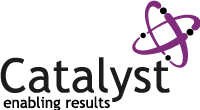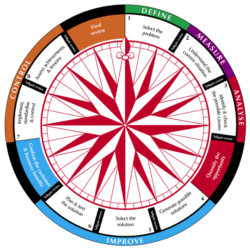Background
Lean Six Sigma is a proven and well-established continuous improvement methodology. Utilising a rigorous, data-driven approach to apply the scientific method, organisations have successfully delivered impactful and sustainable business improvements to their products, services, workflows and other areas, to become more optimal and efficient over time. So how do Agile Techniques work with Lean Six Sigma?
At Catalyst Consulting we have seen an increasing appetite amongst our clients to deliver their Lean Six Sigma improvements much quicker. Many of our clients operate in a world where business agility is essential, so are needing faster-paced outcomes to respond to the demands of the modern world.
Over the last couple of years, we have collaborated with our clients to respond to this challenge and developed innovative ways to accelerate their Lean Six Sigma process improvement initiatives using Agile techniques.
Having taught Agile techniques to experienced Lean Six Sigma practitioners over the last 2 years, we have seen improved results across the board. Where DMAIC business improvement projects are run using Agile techniques, our clients have seen greater pragmatism and a heightened sense of urgency. These projects progress with greater intensity and benefits are delivered in shorter lead times.
How Does It Work?
As you probably already know, traditional DMAIC employs a project-based Phase Gated project management methodology (see right image).
Agile-enabled DMAIC takes the practices and learnings cultivated over the last 20 years in Software Development and upgrades the traditional Waterfall approach, replacing it with incremental and iterative thinking (see below image).
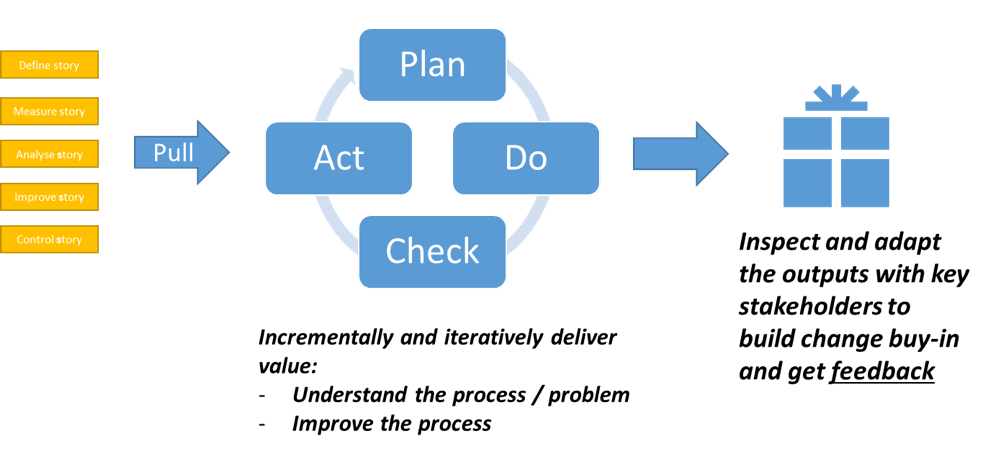
How do Agile Techniques Help?
In Agile-enabled Lean Six Sigma, work belongs to a part of the DMAIC thought-process rather than the project/initiative itself being in a particular phase. We decide the priority of the backlog of work items based on what it is most valuable to the customer of the project/process to avoid batching and over processing; rigorously applying the scientific method with a ruthless balance of risk versus reward.
Clients using this method are no longer talking about months to deliver projects and are instead thinking in terms of days and weeks. For example, output measures baselined in the first few days of the project, and improvements tested and proven in just a few days. When we have a solution, we implement it and measure the outcome.
A common mistake in traditional DMAIC is to keep analysing until we have found enough root causes to meet the project goal. With Agile, when we find a significant root cause and we think it is straightforward to solve, we are encouraged to address it right away, measure the outcome and then decide if we need to come back for more. We’re keeping the rigour of the DMAIC thinking but accelerating speed of delivery too.
Value-Driven Focus
Agile-enabled DMAIC expresses all project needs as “User Stories” (a story approach to writing about needs and functionality, used to capture and communicate requirements).
We further enhance User Stories using the Three C’s pattern (from Ron Jeffries). This efficiently captures the components of a User Story in the form of a “Card, Conversation, Confirmation” narrative.
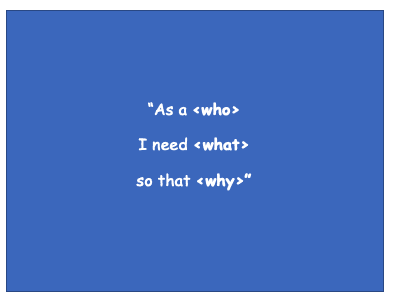
This approach enables us to apply a value-driven thought process and apply conditions of satisfaction for each work item. We split value down so the most valuable elements can flow fast and avoid any over-processing waste.
Timeboxing using Sprints
A common problem with DMAIC projects is finding time to work on the project. Business as Usual so often gets in the way, leading to protracted project cycle times. Applying the Agile technique of timeboxing work into Sprints has proven a valuable antidote (Timeboxing is a time period of fixed length, typically one or two weeks, allocated to achieve a desired objective).
The Agile-enabled DMAIC team works in timeboxed Sprints; their joint goal is to deliver something of value at the end of these focused bursts of activity. We then review the outputs of the Sprint with key stakeholders and use it to guide us on what to do next.
Being Tribal
Borrowing from the popular Agile framework, Scrum, we use tribal “ceremonies” to align the team and stakeholders, to create intensity, and tune the project for success.
These ceremonies encapsulate the Agile philosophy to “maximise the work not done”, along with collaboration, to keep the team working in harmony to deliver the right outcomes.
Sprint Planning
The Team pulls through and commits to the work items they think they can deliver in the next timebox (sprint) typically one or two weeks. This might be the key activities to create the process map and baseline the “y” measures for example.
Daily Stand-up
The team has a short daily meeting, usually a face-to-face conversation, to review the Sprint Plan:
Each team member answers three simple questions:
- What did you get done since yesterday?
- What do you plan to do today?
- Anything blocking you or the team from delivering on the Sprint commitment
This creates a terrific sense of urgency for the team and utilises the natural ability of human beings to firefight. A clever trick / technique – the important strategic work now feels like tactically urgent work.
Sprint Review
At the end of the Sprint, the team and the stakeholders meet to reflect on what has been achieved. The team collects feedback from the stakeholders and uses it as input to decide what to work on in the next time box. This is terrific for Change Engagement and Acceptance as well as making sure we pick the right solution(s).
Sprint Retrospective
Finally, the team meets to reflect on how they worked together during the last Sprint, with a view to become more effective, then they fine tune and adjust behaviour accordingly.
What went well which they want to keep doing or do more of? What didn’t go well that they would like to change. One SMART improvement is agreed upon to implement during the next sprint.
Landing the Plane
Using the Agile Estimation Techniques and Burn Charts, we are also able to pragmatically prioritise the backlog to “right-size” the project to the available time and guarantee the best possible outcome with the committed resources:
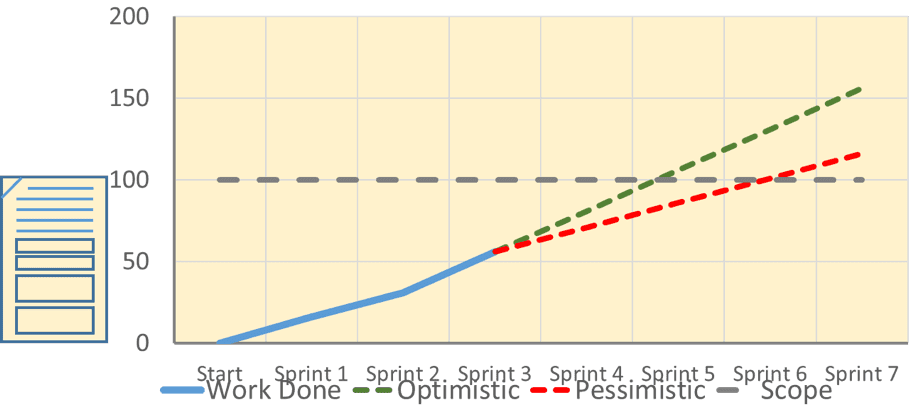
Rinse and Repeat
And the cycle repeats until the Goal of the project has been satisfied. This techniques fosters a much closer dialogue with Sponsors / Process Owners, with iterative negotiation over effort versus payback, and ultimately building confidence in the evolving solution from the outset.
Conclusions so Far
After running pilots and programmes for the past two years, we have been blown away by the success of applying our Agile-enabled Lean Six Sigma approach.
This success has been reflected in the feedback from our clients. Their people have successfully completed our training then promptly applied the Agile-enabled approach to deliver faster-paced outcomes.
Here are some comments below from key people who have been involved, you can also see more testimonials here.
“We have been able to work at a more rapid pace, more clearly defined in terms of activity to complete. We have seen benefits such as turning around projects quicker than before. More togetherness and more shared responsibility. It has been a really, really good experience”
Wayne Fisher, Sky UK
“We were interested in speeding up project delivery as initial projects were taking longer than expected… … but the course has given us an awful lot more”
Electricity Supply Board Ireland
“The course gave my team the skills and tools needed to completely revolutionise the way we run product development. We are now combining best practice from the software industry and LSS to deliver high technology products”
Jolyon Tidmarsh, Keit Spectrometers
Why not try our dedicated training programme teaching Lean Six Sigma / Continuous Improvement Practitioners how to apply Agile techniques to deliver more impactful results in shorter lead times?
Join the revolution today!
Join the revolution today! Be sure to check out our free Strategy Deployment webinar to learn more about Agile techniques.
An inspirational Agile, Strategy Deployment, and Lean Six Sigma coach with infectious enthusiasm and a wealth of experience, James’ clients include several high profile financial services organisations, a medical products supplier, and a local authority.
James is an innovative thinker and is currently collaborating with clients to pioneer new ways of fusing traditional techniques with state-of-the-art. Heavily in demand, his recent work using Agile techniques to accelerate Lean Six Sigma projects is receiving rave reviews from our clients.
